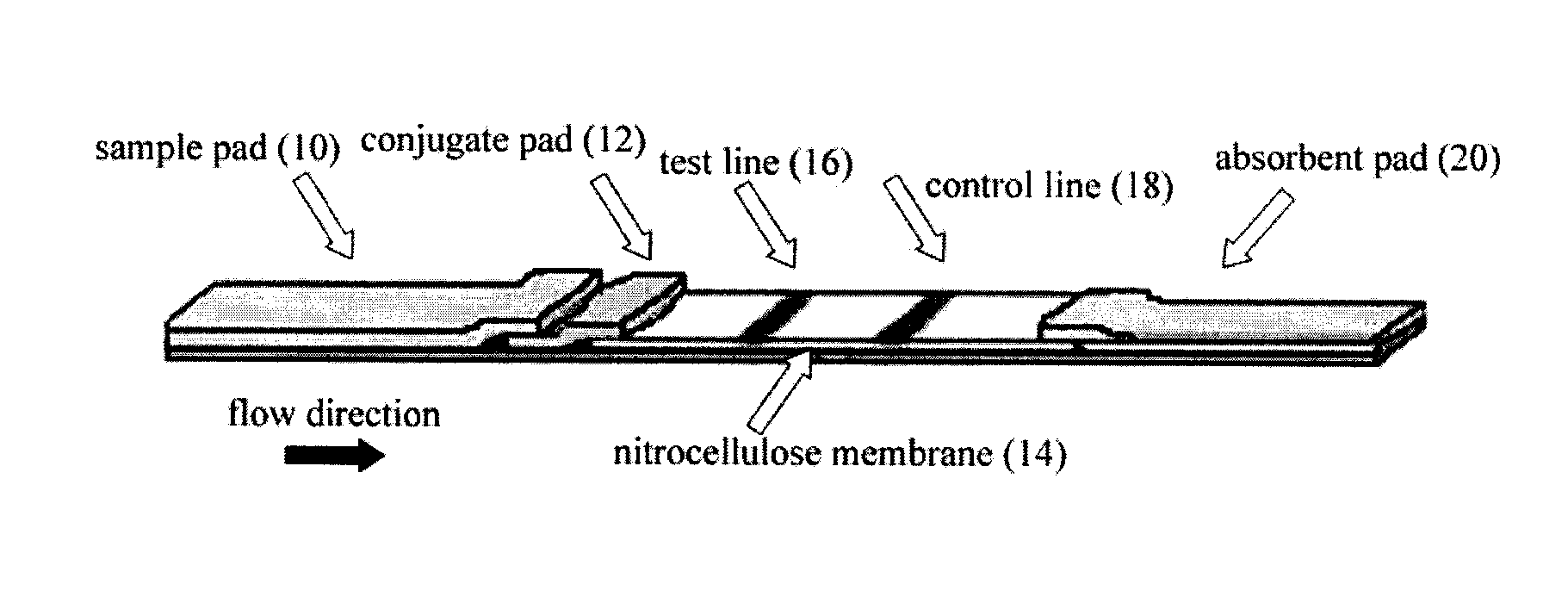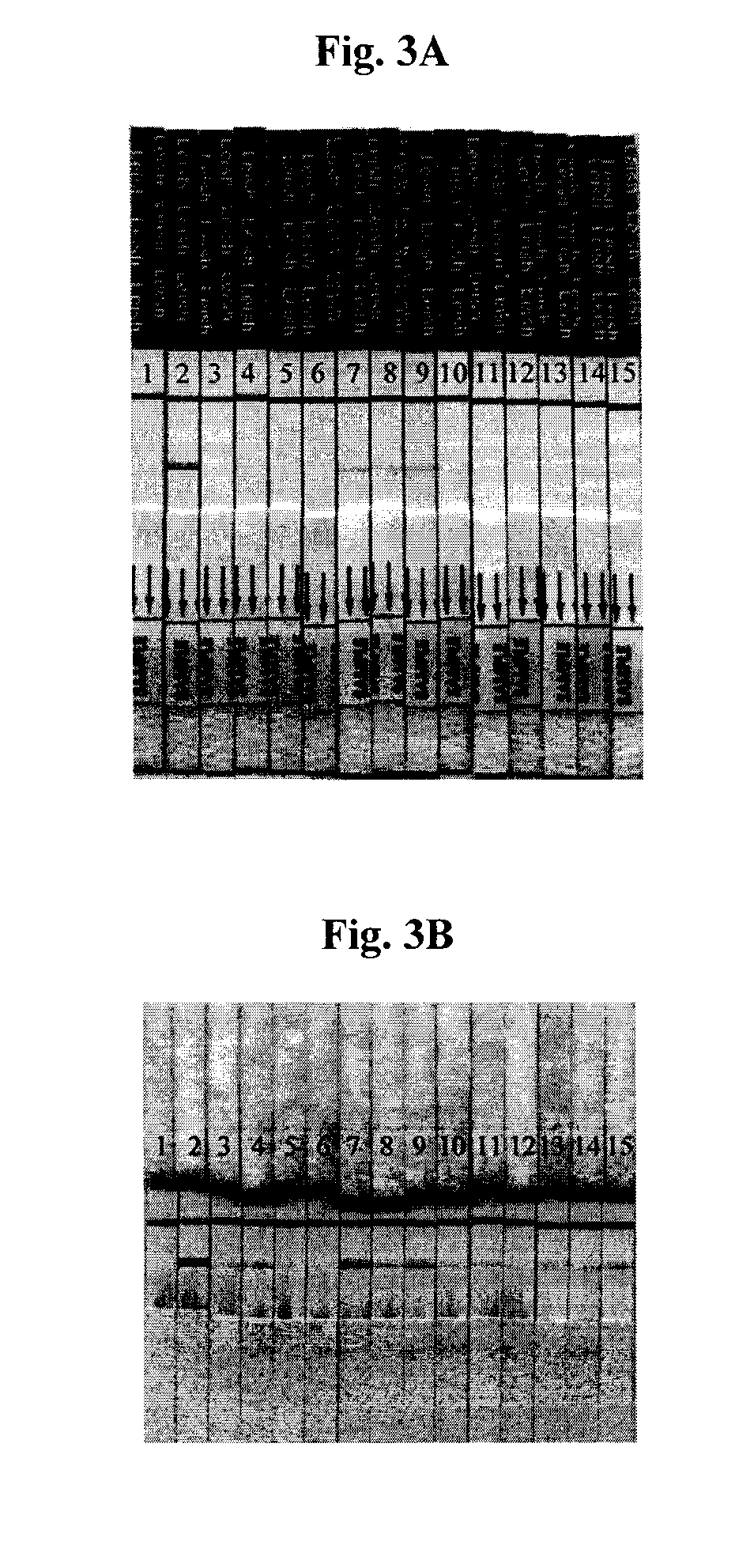Lateral flow assay system and methods for its use
a technology of assay system and assay method, which is applied in the direction of analytical using chemical indicators, laboratory glassware, instruments, etc., can solve the problems of low efficiency, short time, and loose potency and sensitivity of gold conjugates, so as to reduce costs, simplify the manufacture of the device, and reduce the cost
- Summary
- Abstract
- Description
- Claims
- Application Information
AI Technical Summary
Benefits of technology
Problems solved by technology
Method used
Image
Examples
example 1
Detection of Visceral Leishmaniasis (Kala-Azar) Infection
[0043]The well studied recombinant k39 antigen system (Zijlstra et al. Clin. Diag. Lab. Immunol. 5:717-720, 1998) was used to study the ability of the disclosed system to detect the presence of visceral leishmaniasis (also known as Kala-Azar) infection. The antigen was applied at concentrations between 0.025 mg / ml and 1 mg / ml to form a test line, with chicken anti-Protein A being used as the control line. For the conventional system, a conjugate pad with dried gold was used at high concentration that was optimized and selected earlier (Sundar S et al., Jnl. Clin. Microbiol. 44:251, 2006). For the modified system, gold concentration was varied between 0.5 and 5 optical units (measured at 525 nm) in a small volume (1 drop, or 10-20 μl). The volume and OD can be adjusted depending on the system to achieve desired specificity and sensitivity. Performance of the assay was examined using a k39 reactive serum dilution panel, which wa...
example 2
Detection of Trypanosoma cruzi (Chagas) Infection
[0045]In these studies, the Trypanosoma cruzi antigen ITC.8.2 (disclosed in International patent application no. WO 2007 / 056114) was employed in combination with dried gold in the conventional system and liquid gold formulation in the modified system. Various concentrations of liquid gold colloid, between 0.5 and 5 optical units, in a small volume were used. Following application of a small volume of sample (5 μl), a small volume of chase buffer, typically 20-80 μl was used to drive the reaction upward and immediately a small volume, typically 5-50 μl of liquid gold conjugate was added. Once the gold conjugate was absorbed into the test strip, another portion of chase buffer (50-500 μl) was added to help move the gold conjugate through the system. The results of this study are shown in FIGS. 4A-6B. Similar to the Kala-azar system described above, a dramatic improvement in sensitivity was observed using the modified system (results sho...
example 3
Detection of Syphilis Infection
[0051]Cardiolipin is a phospholipid molecule which has been implicated in the diagnosis of syphilis (Pedersen et al., J. Clin. Microbiol. 25:1711-6, 1987). It has been shown that antibodies to cardiolipin exist in patients with active disease. Cardiolipin micelle was used to stripe test lines on a membrane as described. Similar to the above two systems, protein A gold conjugate was used for detection of antibodies in a dilution panel made with confirmed syphilis positive sera. The results (not shown), demonstrate that the gold conjugate in liquid formulation was more active than the dried gold formulation in the conventional system.
PUM
| Property | Measurement | Unit |
|---|---|---|
| concentration | aaaaa | aaaaa |
| concentration | aaaaa | aaaaa |
| volume | aaaaa | aaaaa |
Abstract
Description
Claims
Application Information
 Login to View More
Login to View More - R&D
- Intellectual Property
- Life Sciences
- Materials
- Tech Scout
- Unparalleled Data Quality
- Higher Quality Content
- 60% Fewer Hallucinations
Browse by: Latest US Patents, China's latest patents, Technical Efficacy Thesaurus, Application Domain, Technology Topic, Popular Technical Reports.
© 2025 PatSnap. All rights reserved.Legal|Privacy policy|Modern Slavery Act Transparency Statement|Sitemap|About US| Contact US: help@patsnap.com



